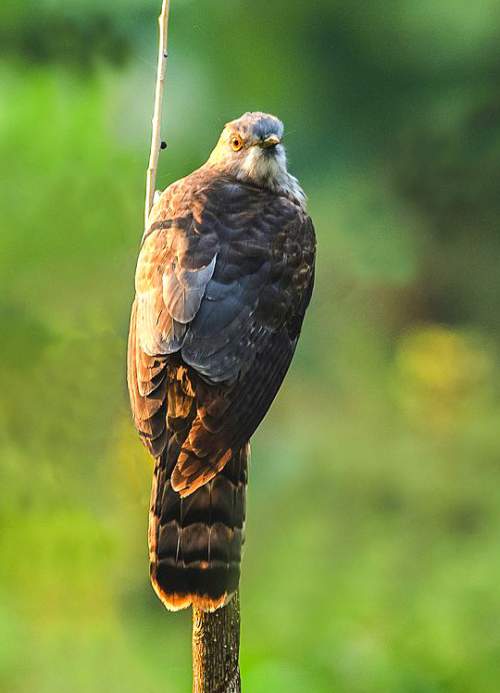The common hawk-cuckoo (Hierococcyx varius), also known as brainfever bird, belongs to the family of cuckoos, Cuculidae. These cuckoo species are distributed in India, Pakistan, Nepal, Bhutan, Bangladesh, Myanmar and Sri Lanka. The common hawk-cuckoo has close resemblance to the shikara (a common hawk species). These cuckoos are brood parasites, laying eggs in the nest of other birds and rely on the host to raise their young.
Common hawk-cuckoo - Overview
- Scientific name: Hierococcyx varius
- Species author: (Vahl, 1797)
- Synonyms: Cuculus varius Vahl, 1797, Cuculus ejulans Sundevall, 1837
- Family: Cuculidae › Cuculiformes › Aves › Chordata › Animalia
- Common Name: Common hawk-cuckoo
- Other languages: Chinese: 南亚鹰鹃, French: Coucou shikra, German: Wechselkuckuck, Spanish: Cuco chikra, Russian: Индийская ястребиная кукушка, Japanese: ハイタカジュウイチ, Hindi: Upak
- Other names: Brainfever Bird
- Distribution: India, Pakistan, Thailand (vagrant), Oman (vagrant), Nepal, Sri Lanka, Myanmar, Bangladesh, Bhutan
- Diet and feeding habits: caterpillars, grasshoppers, locusts, cicadas, winged ants and termites, lizards, fruits, fig, berries
- IUCN status listing: Least Concern (LC)
Appearance, physical description and identification
The common hawk-cuckoo (Hierococcyx varius) is a medium-sized bird measuring about 35 cm in length. It is ashy brown on the upperside and the head is paler grayish brown. The breast region is pale rufous with streaks as in shikara. The underside is white with fine brown cross barring. The tail is whitish with broad dark and pale brown bands.In the flapping of wings, flight movements and perching style, the cuckoo mimic shikara. The squirrels and small birds raise the alarm, as they do on sighting a bird of prey. The males are slightly larger than the females. The male cuckoo makes a loud screaming three-note call which is repeated 4-5 times. The female responds with a series of grating sounds.
 |
| Birds of India - Image of Common hawk-cuckoo - Hierococcyx varius |
 |
| Indian birds - Common hawk-cuckoo - Hierococcyx varius |
 |
| Birds of India - Common hawk-cuckoo - Hierococcyx varius |
Origin, geographical range and distribution
These cuckoo species are distributed in Indian subcontinent and Myanmar. Vagrant birds have been recorded in Thailand and Oman. The subspecies H. v. varius is distributed all over India, Northeast Pakistan, Nepal, Bhutan, Bangladesh and Myanmar. The cuckoo subspecies H. v. ciceliae is distributed in Sri Lanka.Ecosystem and habitat
The cuckoo species inhabit evergreen and semi-evergreen forests, wooded hillsides, deciduous hill forests, partly cultivated farmlands, plantations and parks with dense shady trees. It occurs in elevations of up to 1,000 meters in Himalayan foothill forests and in hills of central Sri Lanka.Diet and feeding habits
The diet of these hawk-cuckoo consists mainly of caterpillars, moths, grasshoppers, locusts, cicadas, winged ants and termites, fruits, fig, berries and lizards.Reproduction and breeding habits
The breeding season of these hawk-cuckoo species is from March to July in India and it is from January to April in Sri Lanka. These cuckoos do not nest. They are brood parasites, laying eggs in the nest of other birds and rely on the host to raise their young. Their preferred hosts are babblers (predominantly Turdoides striatus, T. affinis, T. malcolmi and T. striatus) and laughing-thrushes, as the breeding season of the hawk cuckoo coincides with that of the hosts.Migration and movement patterns
These cuckoo species are mostly non-migratory resident birds. Post breeding dispersal of juveniles takes place. They may make local movements for feeding and breeding. The cuckoo species in higher altitudes descent to lower altitudes during winter.Conservation status and concerns
The global population size of the common hawk-cuckoo (Hierococcyx varius) has not been quantified. The overall population size is considered to be stable. Their generation length is 7 years. These cuckoo species have large range and population. The habitat loss due to deforestation and logging is threatening the survival of these species.The common hawk-cuckoo does not approach the thresholds for being Vulnerable neither under the population trend criterion nor under the population size criterion. The IUCN (International Union for Conservation of Nature) has categorized and evaluated the common hawk-cuckoo (Hierococcyx varius) and has listed it as of "Least Concern".
1.Image source: https://commons.wikimedia.org/wiki/File:Common_hawk-cuckoo.jpg
Image author: Manojiritty | License: CC BY-SA 4.0
2.Image source: https://commons.wikimedia.org/wiki/File:Common_Hawk-Cuckoo_DSC_0279.jpg
Image author: T. R. Shankar Raman | License: CC BY-SA 4.0
3.Image source: https://www.flickr.com/photos/dhruvaraj/2724906868/
Image author: Dhruvaraj S | License: CC BY 2.0 (as on 2016-11-28)
Current topic in Birds of India: Common hawk-cuckoo - Hierococcyx varius.
